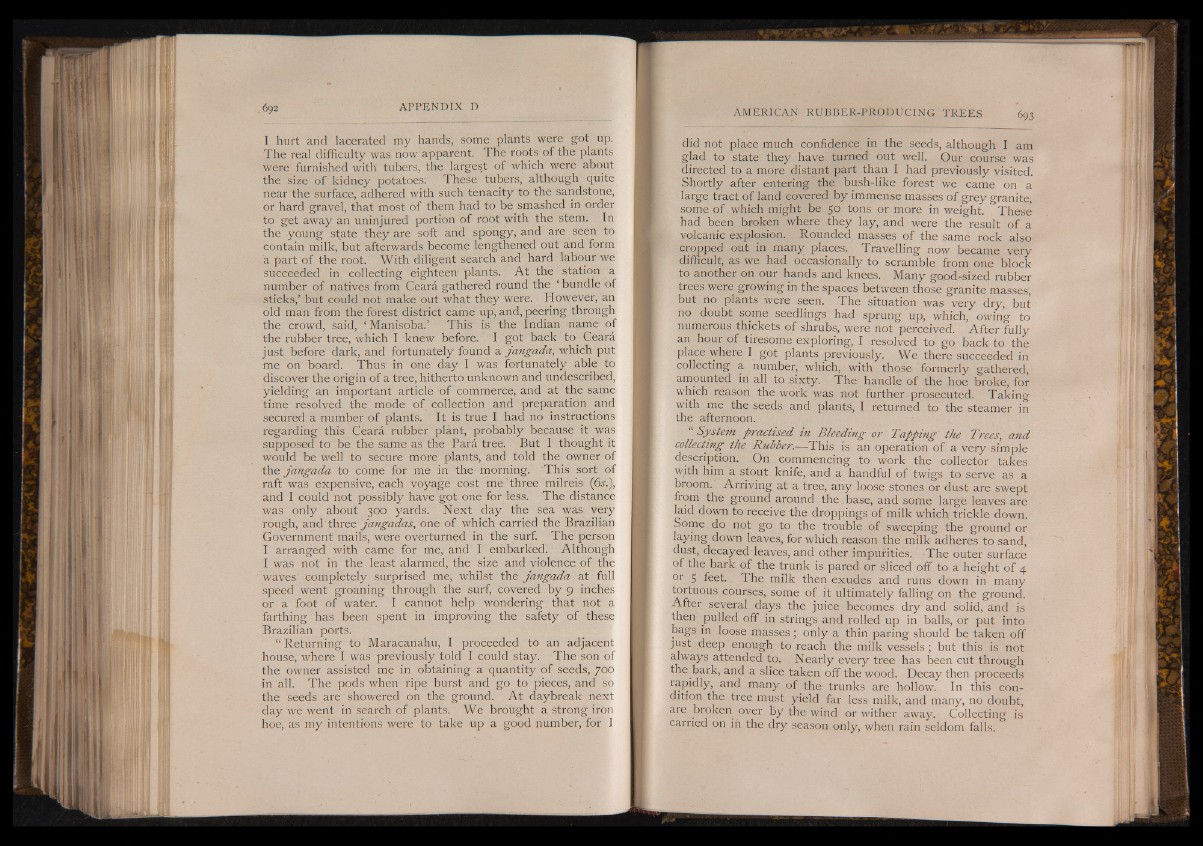
I hurt and lacerated my hands, some plants were got up.
The real difficulty was now apparent. The roots of the plants
were furnished with tubers, the larges.t of which were about
the size of kidney potatoes; These tubers, although quite
near the surface, adhered with such tenacity to the sandstone,
or hard gravel, that most of them had to be smashed in order
to get away an uninjured portion of root with the stem. In
the young state they are soft and spongy, and are seen to
contain milk, but afterwards become lengthened out and form
a part of the root. With diligent search and hard labour we
succeeded in collecting eighteen plants. A t the station a
number of natives from Ceari gathered round the ‘ bundle of
sticks/ but could not make out what they were. However, an
old man from the forest district came up, and, peering through
the crowd, said, ‘ Manisoba.’ This is the Indian name of
the rubber tree, which I knew before. I got back to Ceard
just before dark, and fortunately found a jangada, which put
me on board. Thus in one day I was fortunately able to
discover the origin of a tree, hitherto unknown and undescribed,
yielding an important article of commerce, and at the same
time resolved the mode of collection and preparation and
secured a number of plants. It is true I had no instructions
regarding this Ceara rubber plant, probably because it was
supposed to be the same as the Pari tree. But I thought it
would be well to secure more plants, and told the owner of
the jangada to come for me in the' morning. This sort of
raft was expensive, each voyage cost me three milreis (6s.),
and I could not possibly have got one for less. The distance
was only about 300 yards. Next day the sea was very
rough, and three jangadas, one of which carried the Brazilian
Government mails, were overturned in the surf. The person
I arranged with came for me, and I embarked. Although
I was not in the least alarmed, the size and violence of the
waves completely surprised me, whilst the jangada at full
speed went groaning through the surf, covered by 9 inches
or a foot of water. I cannot help wondering that not a
farthing has been spent in improving the safety of these
Brazilian ports.
“ Returning to Maracanahu, I proceeded to an adjacent
house, where I was previously told I could stay. The son of
the owner assisted me in obtaining a quantity of seeds, 700
in all. The pods when ripe burst and go to pieces, and so
the seeds are showered on the ground. At daybreak next
day we went in search of plants. We brought a strong iron
hoe, as my intentions were to take up a good number, for I
did not place much confidence in the seeds, although I am
glad to state they have turned out well. Our course was
directed to a more distant part than I had previously visited.
Shortly after entering the bush-like forest we came on a
large tract of land covered by immense masses of grey granite,
some of which might be 50 tons or more in weight. These
had been broken where they lay, and were the result of a
volcanic explosion. Rounded masses of the same rock also
cropped out in many places. Travelling now became very
difficult, as we had occasionally to scramble from one block
to another on our hands and knees. Many good-sized rubber
trees were growing in the spaces between those granite masses,
but no plants were seen. The situation was very dry, but
no doubt some seedlings had sprung up, which, owing to
numerous thickets of shrubs, were not perceived. After fully
an hour of tiresome exploring, I resolved to go back to the
place where I got plants previously. We there succeeded in
collecting a number, which, with those formerly gathered,
amounted in all to sixty. The handle of the hoe broke, for
which reason the work was not further prosecuted. Taking
with me the seeds and plants, I returned to the steamer in
the afternoon.
“ System practised in Bleeding or Tapping the Trees, and
collecting the Rubber.— This is an operation of a very simple
description. On commencing to work the collector takes
with him a stout knife, and a handful of twigs to serve as a
broom. Arriving at a tree, any loose stones or dust are swept
from the ground around the base, and some large leaves are
laid down to receive the droppings of milk which trickle down.
Some do not go to the trouble of sweeping the ground or
laying down leaves, for which reason the milk adheres to sand,
dust, decayed leaves, and other impurities. The outer surface
of the bark of the trunk is pared or sliced off to a height of 4
or 5 feet. The milk then exudes and runs down in many
tortuous courses, some of it ultimately falling on the ground.
After several days the juice becomes dry and solid, and is
then pulled off in strings and rolled up in balls, or put into
bags in loose masses ; only a thin paring should bq taken off
just deep enough to reach the milk vessels ; but this is not
always attended to. Nearly every tree has been cut through
the bark, and a slice taken off the wood. Decay then proceeds
rapidly, and many of the trunks are hollow. In this condition
the tree must yield far less milk, and many, no doubt,
are broken over by the wind or wither away. Collecting is
carried on in the dry season only, when rain seldom falls.